Electricity magically transforms your RV from a hardshell tent into a luxurious living space. It’s organized lightning, blue smoke, 21st-century cocaine.
When you plug your RV into a power supply, flowing electricity allows you to flick on your lights, pump your water, watch the TV, run your furnace, and charge your smartphone.
Unlike a house, your RV isn’t permanently connected to the electric grid. You must plug it in. But those plugs … don’t look anything like a regular household outlet!
Welcome to the strange and occasionally dodgy world of RV electrical service.
Today’s topic: What’s the difference between a 30A and 50A RV?
Hint: The answer is not “20A!”
Visual Differences Between 50-Amp and 30-Amp RV Plugs
Before we begin, it’s important to know what the different plugs and receptacles look like. There are four common plugs/receptacles used for RV hookups: two for 30A, and two for 50A. Each amperage has a “straight” and a “twist-lock” version. Oftentimes, you’ll find twist-lock plugs on the RV itself and straight receptacles on the campground power pedestal. (A plug, by the way, has prongs; a receptacle has slots).
You can purchase adapters between straight and twist-lock outlets and vice versa. You can also purchase adapters between the 30A and 50A versions.
30A RV Plugs and Outlets
RV 30-amp plug has a Hot, a Neutral, and a Ground. The receptacle supplies 120 volts AC across the Hot and Neutral leg.
Here’s what a NEMA TT-30R 30A receptacle looks like:
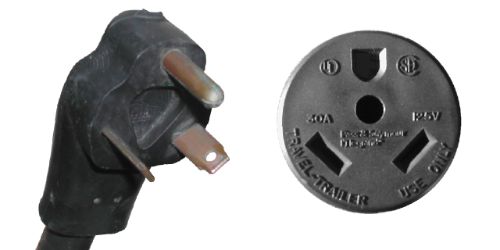
Here’s what a NEMA L5-30 30A twist-lock plug looks like:

50A RV Plugs and Outlets
RV 50-amp plug has two Hot legs, a Neutral, and a Ground. It is a split-phase, double-pole connection. The receptacle supplies 240 volts AC across the two Hot legs or 120 volts AC between each Hot leg (L1 and L2) and the Neutral.
Here’s what a NEMA 14-50R 50A receptacle looks like:
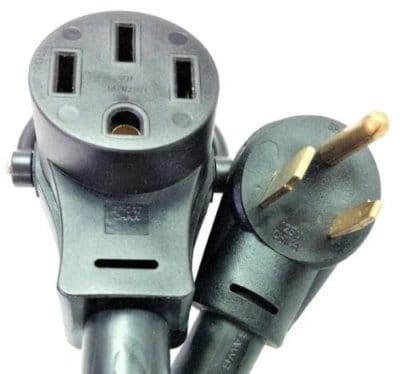
Here’s what a NEMA SS2-50P 50A plug looks like:
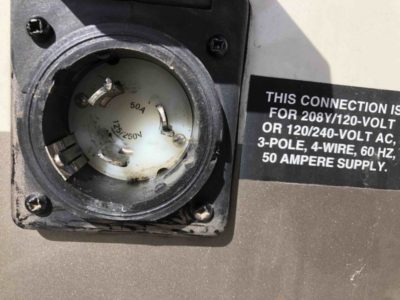
5 Surprising Differences Between a 30A and a 50A RV System
1. (A Lot!) More Power!
Sure, you already know that a 50A connection supplies more power than a 30A connection.
But did you know a 50A connection supplies more than three times (3x) as much power?!
The SuperNerd explanation is that amps don’t equal power. Watts do. And because a 50A connection uses two 120V legs at 50A each, compared to the single 120V leg of a 30A connection, a 50A power supply can supply 3.33 times the power!
If you want to understand this more, learn about Ohm’s Law.
- A RV 30A power supply can provide 3,600 watts
- A RV 50A power supply can supply 12,000 watts
If you’re wondering just how far 3,600 watts can go, I’ve compiled amperage and wattage draw charts for 12V and 120V loads!
Here’s the real-life impact of this difference.
With a 30A power supply, if you’re blasting your air conditioner and then turn on the microwave, there’s a good chance you’ll trip your breaker and shut off power to everything.
With a 50A power supply, you can run two air conditioners, a microwave, a TV, and a coffee maker with no problem!
3. 240V Compatibility
30A RVs cannot run 240V appliances. Full stop.
Conversely, 50A RVs can run 240V appliances (although almost none of them do).
Depending on how your high-end motorhome or 5th wheel is wired, you may have one or two 240V outlets for heavy-duty appliances like a stackable washer and dryer or a full-size electric oven.
To be frank, though, 99 percent of RVs don’t run 240V power. You’ll only find 240V outlets in a few high-end coaches. Most RVs that use 240V service split it into two legs at 120V each.
4. Max Number of Circuits
When you plug your camper into power, electricity is delivered to a circuit breaker distribution panel, often integrated into your converter box. These circuit breakers control your individual circuits.
- 30A RVs are allowed up to five (5) branch circuits (without an energy management system)
- 50A RVs are allowed up to more than five (5) branch circuits, typically up to 12 (limited by box size).
The typical setup of a 30A camper looks like this:
- Air conditioner (20A)
- Microwave (20A)
- Water heater (20A)
- Refrigerator + Outlets
- GFI Outlets
As you can see, there isn’t much room for expansion! No room for multiple air conditioners, multiple refrigerators, or several on-demand water heaters.
5. Limited HVAC Equipment
Only two thermostatically-controlled 120V appliances are allowed in a 30A system.
Impact: With a 30A system, you are limited to two air conditioners or a single air conditioner and a park model furnace!
The only exception to this rule is if your RV uses a listed energy management system, which most don’t.
This is why most larger or longer RVs, which require multiple rooftop air conditioners, are all 50A.
How Is a 50A RV Hookup Wired?
A 50-amp RV power hookup is wired the same as most 1- and 2-family residential buildings: with split-phase 120/240-volt electricity.
Now, I am not a licensed electrician, just a humble mechanical engineer, so I will choose my next words carefully.
As most of you know, electricity is delivered to and from the power station in three phases at high voltage. Where electricity is generated, it is often delivered over transmission lines at incredibly high voltages, up to 800,000 volts! But by the time it goes through the power- and sub-station network and arrives at your house, the distribution line voltage is somewhere between 2kV and 33kV.
We only use a single phase out of the three. A transformer (basically two large coils of wire) is used to step down the voltage to a usable level for our home and RV appliances.
As shown below, in the case of residential electricity, the transformer has a center tap. This becomes the neutral, which carries the unbalanced electrical load between the two power legs. The two power legs, L1 and L2, are at the same line-to-neutral voltage of 120 volts but opposite in polarity (and therefore 180 degrees apart in phase angle) to each other. Therefore, the line-to-line voltage is 240 volts. The “phase difference” between the two legs relative to neutral is a difference in polarity, not in timing.
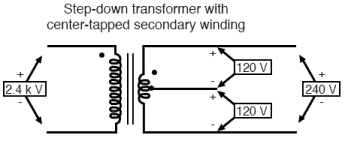
120 and 240 are both nominal numbers. Voltages have crept up over time since higher line distribution voltages increase grid efficiency. Depending on where you live, the actual voltage may be lower or higher than 120/240.
It’s important to realize that this is not a true 2-phase system! It splits a single phase into two hot legs that are OPPOSITE in polarity with a grounded neutral.
FAQs About 30A vs 50A RV Power
How do I stop my 30A breaker from tripping?
If you’re accustomed to the comparatively unlimited power of a 50A connection, camping with only 30A may take some getting used to.
- Run only one 120V appliance (microwave, air conditioner, hairdryer) at a time.
- Install a SoftStart for your air conditioner.
- Run your refrigerator and water heater off propane!
Can I use a 30-to-50/50-to-30/x-to-x adapter?
Yes, you can. There’s nothing stopping you from plugging your Class A motorhome into a tiny 20A household outlet or your budget travel trailer into a 50A power supply!
But you can’t cheat the system. If you plug your motorhome into a 20A household outlet, you’ll only be able to draw 20A before the household breaker trips. So you won’t be able to run more than one 120V appliance at a time.
Conversely, if you plug your 30A travel trailer into a 50A power supply, you’ll still only ever draw 30A (total of 3,600 watts). If you attempt to draw more, you’ll trip the main 30A breaker in your distribution panel.
In fact, you should really carry around several adapters! Older mom n’ pop campgrounds may only offer 30A power.
Can I combine 30A and 20A power supplies to get 50A?
No. That’s not how electricity works. You’ll probably kill yourself. There ARE adapters, however, that plug into a 100-amp power pedestal (the 30-amp and 20-amp outlets) to power the two legs of a 50-amp feeder cable separately.
Can I convert a 30A RV to a 50A RV?
Yes. But it’s pretty involved. It’s beyond the scope of this article, and to be honest, if you have to ask the question, then you probably shouldn’t be attempting this conversion. Electricity doesn’t give second chances!
What does “100 amp service” mean?
If your campground is boasting all their RV sites have “100 amp service,” that doesn’t mean they’re catering to some super high-end type of RV with 100A power supply needs.
It just means the power pedestal at each campsite has three outlets:
- A 50A 120/240-volt connection
- A 30A 120-volt connection
- A 20A 120-volt connection
Add ‘em all up – and that’s your 100 amps.
Do I need a surge protector if I use an adapter?
Yes. You should use an EMS surge protector every time you plug in!
Can I use an extension cord between my power inlet and the power pedestal?
Extension cords cause voltage loss, which increases the amount of amperage you must draw to achieve a certain amount of power.
Translation: The longer the cord, the more amps you’ll draw! You’ll more easily trip breakers or even overheat your appliances.
The workaround is to use larger gauge wire for long wire runs. Here’s a table for some quick rules of thumb. This table errors on the conservative side for 120V electricity with less than a 3% voltage drop.
| For 120V (<3% Drop) | 15 | 20 | 30 | 50 | 100 |
|---|---|---|---|---|---|
| 25 ft | #14 | #12 | #10 | #6 | #4 |
| 50 ft | #12 | #10 | #8 | #6 | #4 |
| 100 ft | #10 | #8 | #6 | #4 | #2 |
| 200 ft | #6 | #6 | #4 | #2 | #1 |
Can I plug my RV into any 50A or 30A connection?
NNOOOOOOOOOOOOOOOOOOOO!!!!!!!!!!!!
There isn’t just one kind of 30A or 50A receptacle. They are wired differently.
This is a NEMA 10-30 receptacle. It is NOT FOR RVs. You’ll find it in some older homes for the dryer outlet.
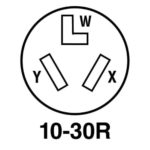
It’s a non-grounded 120/240-volt single split-phase connection. It supplies 240V across the hot legs (the two angled contacts).
Plug your 30A RV into a NEMA 10-30 receptacle, and you’ll fry your converter. Possibly also fry your appliances. And maybe start a fire. These dryer plugs have been made obsolete for a reason.
>> READ MORE: Can I Plug My RV Into My Dryer Outlet? (The Answer Isn’t Always No!)
Or here’s a NEMA 6-50 receptacle. It is NOT FOR RVs. It’s commonly used for welders, plasma cutters, and other machinery.
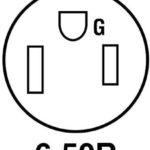
It has no dedicated neutral. It only supplies 240V, 180 degrees out of phase, across the hot legs. It is not safe for RVs.
There’s a reason why your RV power cord doesn’t fit into all receptacles. If your plug prongs don’t fit into the receptacle slots, there’s a good chance the two aren’t compatible – and no adapter will fix that fact!
Leave a Reply